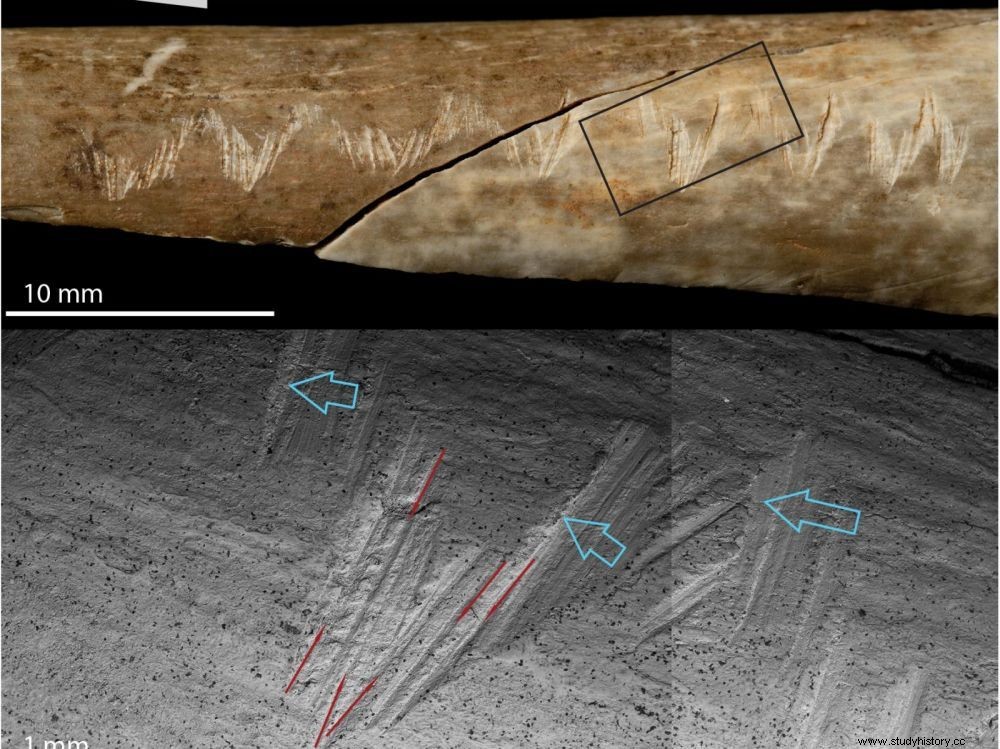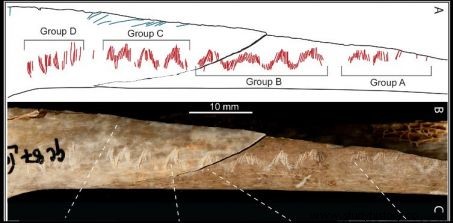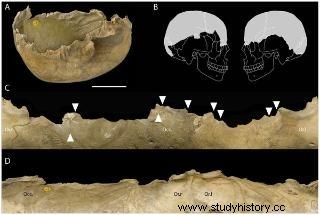Examination of a 15,000 year old human radius shows that it was carved, and confirms that ritual cannibalism was practiced in Gough's Cave, in Great Britain, already famous for its skulls transformed into cups.

The cave of the cannibals of Gough (Great Britain) delivered a human radius engraved with zigzags.
These are only a few zigzags… but they were carved about 15,000 years ago on a human radius in Gough Cave (Great Britain) already known for its carved skulls. They could be the mark of “earliest known ritual cannibalism ", according to anthropologist Silvia Bello, of the Natural History Museum in London. The remains of six people - a child, two teenagers and three young adults - butchered and consumed were exhumed in this shelter occupied by hunters from the Magdalenian period (between -18,000 to -12,000 years ago) at a time when the British Isles formed a peninsula of Europe.Even their toes were stuffed...As for their skulls, they were hollowed out and shaped to make cups that can hold up to two pints of liquid (Editor's note:just over a liter), shows a study published in 2011.
The surprise comes from the new examination, under an electron microscope, of a radius extracted from the mass grave:it bore astonishing engravings. Silvia Bello and her colleagues were able to scrupulously reconstruct the appalling sequence. The arm bone (just like its owner) was disarticulated, emaciated, its muscles were removed in fillets, the tendons pulled out. The radius was then flattened to be engraved, over 3 cm, with a sharp flint. It was finally broken to extract its marrow, sucked, nibbled before being simply… discarded. "We don't know if the Magdalenian hunter who worked on this portion of remains was left-handed or right-handed, or even if he was alone ", agrees Silvia Bello.

Lines of zigzags were revealed by microtomographic studies. © Sylvia Bello.
On the other hand, the researchers are formal, "the zigzags are not the mark of a work of cutting the carcass ". To find out for sure, they compared the eighty-seven incisions of the radius to two hundred and seven marks on human bones and one hundred and fifteen on animal bones, horse ribs, hare tibia, deer remains, etc. Verdict:they don't have the same width and weren't induced by the same gesture.
Carefully scalped and emaciated skulls
The use of human bones as raw material to produce utilitarian or symbolic tools is rare in Paleolithic Europe. A few human fragments, transformed into retouchers for tools, were exhumed on the site of La Quina (Charente). Other bones, discovered in Brassempouy and Duruthy (Landes), and Isturitz (Pyrénées Atlantique) do bear zigzag engravings, but these smoothers for the skins were made from the ribs of large mammals.
Five cups cut from skulls have indeed been found in the cave of Le Placard, in Charente, occupied around 18,000 years ago. But no carvings on human bones were found there. A possible cranial cup was exhumed in the cave of Isturitz, of the same age as that of Gough, as well as fragments of parietal bone marked with streaks and a shape evoking an animal body… but this interpretation remains debated, according to Silvia Bello.
It is therefore a unique object for the Magdalenian period that was discovered at Gough, according to the authors. Does it have any special meaning? Unquestionably for London anthropologists.

Sculpted skulls could have been used as drinking cups by Magdalenian hunters in Gough (Great Britain). © Sylvia Bello.
"The way the skulls were carved and the fact that the radius was engraved suggests that cannibalism was not only practiced for nutritional reasons but also in rituals “, they explain. The floor of the cave being strewn with abundant animal bones, cannibalism for survival would even be excluded. skull to gain direct access to this organ, the fattest in the human body? “, wonders Silvia Bello. Carefully scalped and emaciated, the skulls show no trace of teeth. The cranial vault has been delicately detached from the jaw, its shape preserved to make a cut.
Warrior or funerary cannibalism?
Sylvia Bello sees these gestures as a ritual effort, rather than a utilitarian behavior. "The bones - including the radius - bear cut marks, similar to those inflicted on game carcasses, but no wounds or trauma, suggesting a natural death of their owners " she underlines. The researcher therefore thinks to have the trace of a ceremonial cannibal funeral. The first in the world.
A specialist in practices around death and the treatment of corpses in ancient societies, Bruno Boulestin, doctor and anthropologist at the University of Bordeaux, is not convinced:"On bones broken multiple times, it is very difficult to distinguish the traces of cuts from those of violence or killing "explains the one who has studied many prehistoric "mass graves". And some murders do not leave marks... "An arrow rarely hits the bone" , he adds. Strangulation, strangulation, suffocation can also be impossible to detect, after thousands of years, on bodies that are otherwise in a thousand pieces.
"Until then, almost all cupped skulls documented by ethnohistory are skulls of enemies, not skulls of members of the same group “, further recalls the French anthropologist. If there was a ritual in Gough, “it was rather warlike and not funerary cannibalism ", according to him. The question will no doubt continue to divide specialists.
Continuing their forensic investigation, the London researchers, for their part, took DNA samples to try to determine if the engraved radius belonged to one of the people whose skull was carved.
